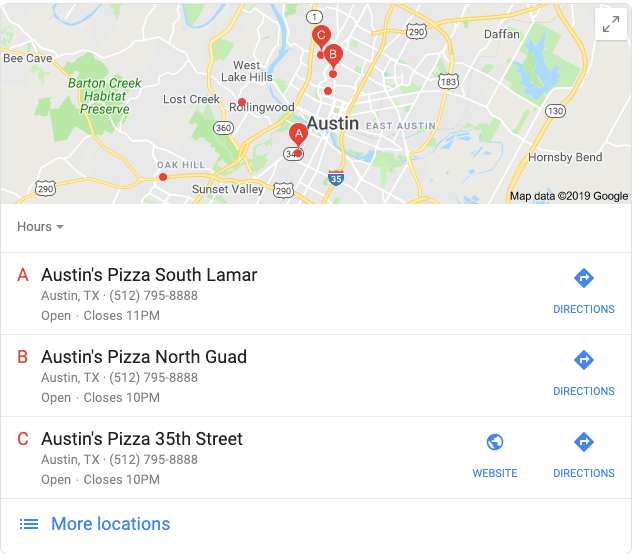- 88% of local business searches on a mobile device either call or visit the business that was searched within 24 hours. (Nectafy)
- Almost 50% of all Google searches are related to finding local businesses and services. (SEO Expert)
- 97% of internet users search online to find local businesses and services. (HubSpot)
We’ve written about SEO a lot because, well, it’s important. It’s rare to run into a business, no matter how big or small, that isn’t at least somewhat familiar with the concept of SEO (search engine optimization). If you have any kind of online marketing strategy in place, it should include an SEO strategy, even if it’s just using keywords in your content to help drive organic search traffic.
While you’ve heard of SEO, you may still be unfamiliar with local SEO. If you run a business that depends on locals, foot traffic, or in-store purchases, then local SEO is an incredibly important component of your SEO efforts that you need to be sure to address ASAP.
What is Local SEO?
The technical definition: Local search engine optimization is the practice of building signals of relevance around specific locations of a brick and mortar business.
What does that mean, though?
People don’t just search online for websites and social media–they often search for businesses and services that are provided near to their location. The stat at the beginning of this post said it all: Almost 50% of all Google searches relate to finding local businesses and services. This means there are customers in your area searching for things like “Pizza near me” or “House cleaning services” or “HVAC repair.” Local SEO deals with the searches that users do to find products and services in local, physical locations.
These are the types of customers that you want to attract to your local business since they are the ones that are the most likely to convert by making a call or visit that can result in a purchase. When it comes down to it, local SEO involves optimizing your online content for a specific location to attract calls and visits to your physical location, not just your website.
The Benefits of Local SEO
By implementing a strong local SEO strategy, it will be easier for local customers to find you on search engines like Google or Bing. In fact, if you properly optimize your site for local SEO, Google will be more likely to bring your business up in their snack pack results of the search query, which is the box that appears at the top of the SERP (search engine results page) that displays three local businesses that best match the query.

The “snack pack” results are the 3 top results that appear under the Google map during a local search.
Essentially, local SEO helps to increase exposure to local customers and drive more high-quality traffic to your site as well as to your physical location.
Local SEO Tactics
The following are a few local SEO tactics that you should implement into your overall SEO strategy to help boost your rankings:
- Optimize for mobile use. Many people search for businesses while they’re out and about. For example, if they’re on the go and need a quick bite to eat, they may look up certain types of restaurants in the area. To ensure that your business shows up in these types of queries to help drive foot traffic, you need to optimize your site for mobile use so that it will load properly on smartphones.
- Use local keywords. Use local keywords throughout your content whenever it’s appropriate to do so. For example, the names of towns, neighborhoods, other local businesses, famous local landmarks, local sports teams, and more.
- Set up local landing pages. Having landing pages that are optimized for the area you’re in. If you have multiple locations in different areas, then you should have multiple landing pages for each area you’re in.
- Set up Google My Business. Google My Business lets you manage your online presence across Google by submitting your company name, address, exact location, website link, opening hours, and much more.
- Submit NAP citations.NAP (name, address, phone number) citations are one of the top five local ranking factors according to Moz. Make sure your NAP is correct across all platforms and submit it to local directories, such as community hubs, local business directories, and the local chamber of commerce.
- Create local content. Create blog posts that are area specific. For example, write about local events being held near your store location or things to do after visiting your business.
- Create guest blogs for local sites. Write blog posts for other businesses in your location. This is a great way to get exposure to an already established audience that is likely going to be local.
- Encourage online reviews. The more online reviews you have, the easier it will be for locals to find you. Many people will do searches for services and products on review sites like Yelp, Google Reviews, and Angie’s List (just to name a few) to get an idea of what’s available near them and what their reputation within the area is.
A Last Thought
If you run a local business or you have physical locations, local SEO will help drive local traffic, increasing your chance of attracting local customers to your physical locations. It’s critical that you start a strategy now if you don’t already have one. Build slowly, over time, based on your bandwidth. We suggest Google My Business as the first step!
-FINAL(01-00)-White&Blue-01.svg)





